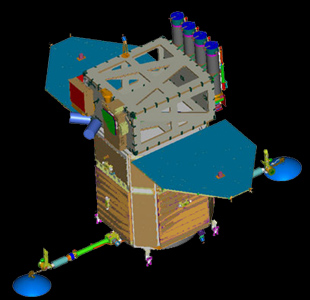Thank you very much for visiting Gunter's Space Page. I hope that this site is useful and informative for you.
If you appreciate the information provided on this site, please consider supporting my work by making a simple and secure donation via PayPal. Please help to run the website and keep everything free of charge. Thank you very much.
SDO

SDO [NASA]
The SDO (Solar Dynamics Observatory) solar observing satellite will be a follow up to SOHO. SDO has four main goals:
- Research on the Solar Cycle.
- Identify the role of the magnetic field in delivering energy to the solar atmosphere and its many layers.
- Study how the outer regions of the Sun's atmosphere evolve over time - ranging from seconds to centuries - and space.
- Monitor the radiation (ex: UV, EUV, etc.) levels of solar output.
SDO will contain a suite of instruments which will provide the observations that will lead to a more complete understanding of the solar dynamics that drive variability in the Earth's environment. Following instruments are mounted on the spacecraft:
- HMI (Helioseismic and Magnetic Imager):
The Helioseismic and Magnetic Imager will extend the capabilities of the SOHO/MDI instrument with continuous full-disk coverage at considerably higher spatial and temporal resolution line-of-sight magnetograms with the optional channel for full Stokes polarization measurements and hence vector magnetogram determination. - AIA (Atmospheric Imaging Assembly):
The Atmospheric Imaging Assembly will image the solar atmosphere in multiple wavelengths to link changes to surface and interior changes. - EVE (Extreme Ultraviolet Variablity Experiment):
The Extreme Ultraviolet Variablity Experiment will measure the solar Extreme-Ultraviolet (EUV) irradiance with unprecedented spectral resolution, temporal cadence, and precision.
The large data outtput (> 1 TByte/day) dictated the use of a geostationary orbit for continuous data downlink via a Ka-band transponder.
| Nation: | USA |
|---|---|
| Type / Application: | Solar Observatory |
| Operator: | NASA Goddard Space Flight Center |
| Contractors: | NASA Goddard Space Flight Center |
| Equipment: | HMI, AIA, EVE |
| Configuration: | |
| Propulsion: | R-4D |
| Power: | 2 deployable fixed solar arrays, batteries |
| Lifetime: | 5 years (design); 10 years (fuel) |
| Mass: | 3100 kg |
| Orbit: | inclined GEO |
| Satellite | COSPAR | Date | LS | Launch Vehicle | Remarks | |
|---|---|---|---|---|---|---|
| SDO | 2010-005A | 11.02.2010 | CC SLC-41 | Atlas-5(401) |
References:
Further LWS (Living with a Star) missions:
- SDO (LWS 1)
- SET 1 (LWS 2)
- RBSP A, B → Van Allen Probe A, B (LWS 3)
- BARREL (LWS 4) balloon campaigns
- Solar Orbiter (SolO) (LWS 5)
- Parker Solar Probe (Solar Probe Plus, LWS 6)
- HERMES (LWS 7)
- GDC 1, 2, 3, 4, 5, 6 (LWS 8)
